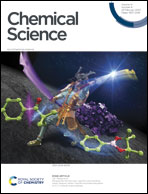Polarization-induced nanohelixes of organic cocrystals from asymmetric components with dopant-induced chirality inversion†
Abstract
Supramolecular chirality is essential for the development of functional materials. In this study, we report the synthesis of twisted nanobelts based on charge-transfer (CT) complexes using self-assembly cocrystallization starting from asymmetric components. An asymmetric donor, DBCz, and a typical acceptor, tetracyanoquinodimethane, were used to construct a chiral crystal architecture. An asymmetric alignment of the donor molecules induced polar ±(102) facets that, accompanied with free-standing growth, resulted in a twisting along the b-axis due to the electrostatic repulsive interactions. Meanwhile, the alternately oriented ±(001) side-facets were responsible for the propensity of the helixes to be right-handed. Addition of a dopant significantly enhanced the twisting probability by reducing the surface tension and adhesion influence, even switching the chirality preference of the helixes. In addition, we could further extend the synthetic route to other CT systems for formation of other chiral micro/nanostructures. Our study offers a novel design approach for chiral organic micro/nanostructures for applications in optically active systems, micro/nano-mechanical systems and biosensing.



 Please wait while we load your content...
Please wait while we load your content...